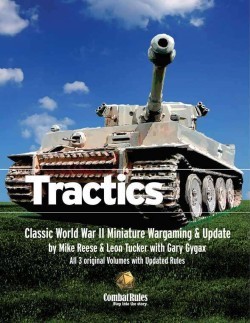Tractics
 |
Tractics is available again and updated! The rulebook includes the original Classic edition¸ the Little Wars Modifications¸ and is Updated as of December 2021. Twenty pages of examples help clarify how the rules are used.
The PDF is identical to the printed options noted at Combat Rules: it has landscape-view game reference charts¸ color throughout ¸ and letter-sized pages.
This PDF boasts clickable links in a detailed Table of Contents with 81 entries¸ hundreds of in-text references¸ an Index of hundreds of entries¸ Bookmarks¸ and the Game Reference Charts.
Many weapons have been added. There are now 226 (138% more than the first edition's 95) vehicle data listings with seven new nationalities and five new gun bore/caliber combinations for a total of 29.
New rule section options: Opportunity Fire & Markers¸ Getting Stuck¸ Auto-Observation & Detection¸ Direct Area Fire¸ Remote Control AFVs¸ Command Distances & Orders¸ Vehicle Size Modifiers¸ simplified automatic weapon bursts¸ Grenades/Close Assault¸ incremental Building and Bridge destruction¸ streamlined Aircraft & AA¸ Night & Weather¸ Gun Crews¸ Barrage Areas. Area Fire Weapon Effects.
Note that while the modern rule section is included¸ it is not updated. The modern vehicle data listing charts may be downloaded free of charge. Updated Tractics is focused on World War II.
Restrictions: Text cannot be copied and pasted. Photos are at a screen resolution¸ so printed images will look fuzzy. However¸ because the Charts are mostly vector art¸ printing the Game Reference Charts' pages will 99% be sharp.
About the Rules
Bill Owen¸ publisher:
Tractics was the first miniature wargame to provide a complete wargame ruleset. All aspects of World War II are included in a skirmish-level game¸ typically played with a platoon to a company of model vehicles and soldier figures. However¸ after gaining experience with the system¸ some have played it with more tanks and a team (half-squad)¸ or squad stands for infantry. Being complete¸ it is unlike contemporary rulesets that have multiple supplements.
Mostly a D20 and occasionally D6 are used for all rolls. D20 gives a level probability in 5% steps. Tape Measures in inches or centimeters are typically used for 15-28mm or 6mm¸ respectively.
The Direct Fire Mode is the core of the Tank and Anti-Tank fire system. A base number is modified by a variety of bonuses and penalties to determine the chance for each shell to hit an enemy AFV. Then one rolls to see where the shell hit and estimates the angle of the fire. This angle adjusts the effective armor and may mean the shell's penetration falls short. The game provides hundreds of vehicle data charts with armor thickness in millimeters and angle of "slope." The slope increases the effective armor thickness. If the round penetrates¸ then one rolls for the level of damage from none but possible casualties and steps up to explosive destruction.
A key improvement is the addition of Opportunity Fire. The first edition had a rule called Covering Fire that did not work well. The Turn Sequence changed to include Op Fire in the Modified rules. Still¸ we are now calling them Updated because we have fine-tuned the phases to integrate Markers (puffs of cotton "dust" or cotton "smoke") to clarify the status of fires and moves plus other steps like Artillery¸ Morale¸ Orders¸ etc.
Observation & Detection now has an updated option where the gamer does not need to tell where each observer is looking. One rolls for this instead.
The Infantry system has levels of detail: 1) similar to DFM 2) Condensed version 3) teams and squads modification from the free Duckbills newsletter.
Likewise¸ Artillery has an Indirect Fire Mode presented in a more streamlined fashion. The update adds a mode and simplifies the IFM.
One must keep the first few games with few forces. The advantage is that the rules give a precise outcome that writes the nar